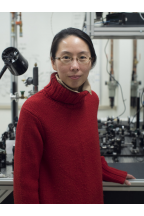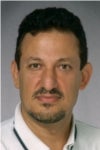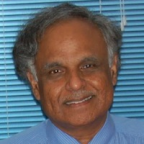Professor Information:
Hany Aziz is a professor in the Department of Electrical and Computer Engineering with a cross-appointment to the Department of Chemical Engineering. He served as the Associate Director of Waterloo’s Nanotechnology Engineering program from 2015-2019. He is also Associate Director of the Giga-to-Nanoelectronics Centre. He previously held the appointment of NSERC- DALSA Research Chair in organic electronics.
Dr. Aziz’s group conducts research in the interdisciplinary area of organic electronics and optoelectronics including both electroluminescent (such as Organic Light-Emitting Devices or OLEDs and quantum dot LEDs ) and light harvesting (such as organic photovoltaics and optical sensing) materials and devices. The research spans a wide range of areas ranging from studying fundamental phenomena in organic semiconductors (such as carrier injection and transport, exciton dynamics, carrier-exciton interactions) to developing novel devices and fabrication technologies for next generation electronics (such as flexible flat panel displays and printable electronics).
Dr. Aziz’s research contributions are widely cited in the organic electronics community, and have resulted in over 150 peer-reviewed publications to date. He has several inventions including the industry’s benchmark long-life and thermally-stable OLED and the contrast enhancing Black Cathode™ Technology. He holds 51 U.S. patents. In 2020 he was awarded a University Research Chair.
-
Organic electronics
-
Optoelectronic materials and devices
-
Charge and energy transfer in amorphous semiconductors
-
Materials for flexible and printable electronics
-
Nanotechnology
-
Additive manufacturing
-
Renewable energy
-
Nano-electronics
-
Organic light emitting devices (OLEDs)
-
Organic photovoltaics
-
Optical sensing imaging
Chris Backhouse is a Professor in the Electrical and Computer Engineering department at the University of Waterloo.
His research interests include nano-biological technology based quantum devices, medical diagnostics, miniaturization and microfluidic lab-on-a-chip systems.
Following graduation at the University of British Columbia, Professor Backhouse held academic and industrial fellowships in electrochemistry with the university and in non-invasive medical imaging with CTF Systems. Working together with Applied Biosystems, a life technologies company, he developed large-scale microchips and their fabrication technologies for use in the Human Genome Project. Professor Backhouse also led a research team in developing genetic analysis instrumentation that is now being sold internationally.
Professor Backhouse’s research work was recognized by the Association of Professional Engineers, Geologists, and Geophysicists of Alberta and was awarded the Summit Award for Project Achievement in 2008. His accomplishments were also recognized by Engineers Canada, thus presenting him with the National Award for an Engineering Project of 2009. In addition to his many accomplishments, Professor Backhouse has written numerous articles and journals through IEEE and other various organizations.
-
Quantum devices
-
Biomedical engineering
-
MEMS/MOEMS and CMOS integration
-
Lab on chip
-
Medical diagnostic devices
-
Microfluidic devices
-
Radio astronomy
-
Sensors
-
Microfabrication
-
Remote sensing
-
MEMS/NEMS
-
Nanotechnology
Dayan Ban is a professor in the Department of Electrical and Computer Engineering, Associate Director for the Centre for Intelligent Antenna and Radio Systems, and a researcher at the Waterloo Institute for Nanotechnology. His expertise lies in the conversion of near infra-red light directly to visible light, design and fabrication of high-performance quantum devices and the development of ultra-sensitive surface plasmon sensors.
Dr. Ban successfully improved the efficiency of hybrid organic/inorganic devices by more than one order of magnitude and applied time-domain terahertz spectroscopy to study the device physics of terahertz quantum cascade lasers. Dr. Ban’s research has also accomplished the fabrication of prototype hybrid organic/inorganic devices by direct tandem integration and the study of the effects of interfacial states on device performance. These devices are responsible for the conversion of near-infrared light directly to visible light (green) at room temperature.
Dr. Ban pioneered the development of new methods in scanning probe microscopy to observe, with nanometric spatial resolution, two-dimensional profiles of conductivity and potential inside actively-driven lasers. He also resolved the nanoscopic reason for anomalously high series resistance encountered in ridge waveguide lasers. In addition, Dr. Ban reported the first direct experimental observation of electron overbarrier leakage in operating buried heterostructure multi-quantum-well –lasers. His work has provided the first experimental visualization of the inner workings of operating semiconductor lasers, and has also provided a platform for enabling tools for quantum semiconductor device and nanotechnology research.
- Semiconductor quantum devices
- Photonics
- THz technology
- Nanotechnology
- Atomic force microscope
- Fiber-optical communication system
- Silicon Devices
- Terahertz Quantum Cascade Lasers
- Biophotonics
- Scanning Probe Microscopy
- Connectivity and Internet of Things
- Nanofabrication
- IoT
- Devices
- Application domains
Slim Boumaiza is a Professor in the Department of Electrical and Computer Engineering at the University of Waterloo.
His research is focused on defining, conceptualizing, designing, and realizing high-performing microwave and millimeter wave circuits and systems for wireless communications (with applications in 4G, 5G and the Internet of Things). He directs the Emerging Radio System Research Group (EmRG), which conducts multidisciplinary research encompassing the semiconductor device, circuit, and system levels of radio hardware. Under his supervision, researchers investigate the areas of transistor modelling and characterization (at the semiconductor device level), ultra wideband and highly efficient power amplifiers (at the circuit level) and low power linearization schemes (at the system level).
In the above research areas, Dr. Boumaiza has authored and co-authored over 65 refereed journal publications, over 120 conference publications, been granted 7 patents with 3 more pending, and delivered numerous keynotes, workshops and talks to members of academia and industry.
He is passionately involved in communicating knowledge of radio systems through teaching, supervision, and youth outreach. He has taught several undergraduate and graduate courses covering basics of electrical engineering and advanced topics in microwave engineering. Over 100 highly qualified personnel (undergraduate, master's, and PhD students, post-doctoral fellows, and other research staff) have worked under his supervision to date. Many have gone on to secure highly sought-after positions in industry. Dr. Boumaiza and his team also actively participate in university-led efforts to engage youth and minorities and promote their interest in engineering.
-
Microwave and Millimeter Wave (mm-wave) Circuits and Systems
-
High Efficiency Power Amplifiers for Wireless Communications (sub 6 GHz and mm-wave)
-
Digital Predistortion Techniques for 4G and 5G Power Amplifiers and Massive MIMO\/Beamforming Transmitters
-
Nonlinear Microwave Circuits Characterization and Modeling
-
Advanced Circuits and Systems for Microwave and mm-wave Radio Front-ends (printed circuit boards and integrated circuit technologies)
-
Advanced Signal Processing for Wireless Communications
-
5G Radio Hardware
Vincent Gaudet is a Professor in the Department of Electrical and Computer Engineering at the University of Waterloo.
His research interests focus on high-speed and energy-efficient microelectronic circuits applied to digital communication systems and signal processing. He is particularly interested in stochastic computing systems and multiple-valued logic. He has worked on low-density parity-check (LDPC) and turbo decoders, multiple-access channels, implantable neural recording systems, and integrated lab-on-chip instrumentation circuitry.
Professor Gaudet is currently a Senior Member of the IEEE, and holds many editorial positions. In 2009, he received the Petro Canada Young Innovator Award to recognize and support his work of outstanding young faculty-based research.
-
VLSI circuits
-
Analog circuits
-
Mixed-signal circuits
-
Digital circuits
-
CMOS design
-
Low-power circuits
-
LDPC decoding
-
Turbo decoding
-
Iterative decoding
-
Stochastic computation
-
Connectivity and Internet of Things
-
Digital design and fabrication technologies
-
Embedded systems
-
Information systems
-
Sensors and devices
-
Wireless communications/networking
-
Microelectronic circuits
-
Digital communications
-
Signal processing
-
Connectivity and Internet of Things
-
IoT
-
Devices
Dr. Karim S. Karim is a Professor in Electrical and Computer Engineering at the University of Waterloo. He has raised more than $15M in research grant funding, trained over 40 PhD and MASc students, has co-authored 250+ publications and 50+ patents. He is also a founder and Chief Technology Officer of KA Imaging, a University of Waterloo spinoff that makes innovative X-ray detectors and systems for medical, veterinary, scientific and industrial markets. Dr. Karim has developed novel imaging devices and systems since 1998 and has both supported and founded multiple startups in the past two decades. One of his “color” X-ray innovations is now starting to replace black and white medical X-ray globally while another is used in ultrasonic fingerprint sensors in mobile phones and tablets.
-
Spectral X-ray Imaging
-
Phase Contrast X-ray Imaging
-
Medical Imaging
-
Large area electronics
-
Semiconductor Devices and Fabrication
Na Young Kim is an Associate Professor in the Department of Electrical and Computer Engineering. She has an affiliation with the Institute for Quantum Computing and and Waterloo Institute for Nanotechnology and cross-appointments with the Department of Physics and Astronomy and the Department of Chemistry.
Na Young leads the Quantum Innovation (QuIN) laboratory, which aims to build large-scale quantum processors based on novel materials and advanced technologies. Two kick-off projects are under way: (1) a semiconductor quantum processors project that establishes controllable optical and electrical domains, in which her research team is learning insights of exotic materials and the fundamental nature of symmetries, and (2) a project in which a multi-functional classical and quantum device arrays establishes a planar architecture comprised of nano-scale devices with electrical, optical, thermal and mechanical functionality.
Prior to joining the University of Waterloo in 2016, Na Young worked for Apple Inc. developing small display products. She received a BS in Physics from Seoul National University and pursued her graduate studies exploring mesoscopic transport properties in low-dimensional nanostructures in the Department of Applied Physics at Stanford University. During her postgraduate research, she expanded her scope to the fields of quantum optics and nanophotonics, working on several experimental and theoretical projects in collaboration with graduate students, postdoctoral scholars and collaborators.
-
Large-Scale Solid-State Quantum Computer
-
Quantum Simulator
-
Quantum Information Processing & Communications
-
Quantum Artificial Intelligence
-
Quantum Security
-
Nanotechnology
Peter Levine is an Associate Professor in the Department of Electrical and Computer Engineering at the University of Waterloo. His research group develops complementary metal-oxide-semiconductor (CMOS) integrated circuits (ICs) that translate the chemical world of biology to the digital world. By combining standard CMOS analog/mixed-signal ICs with novel structures, materials, or devices, he and his team are developing advanced CMOS imagers and biosensors for a wide range of life-science and biosensing applications.
-
CMOS analog/mixed-signal integrated circuits (ICs)
-
CMOS electrochemical biosensors
-
CMOS imagers (visible, IR, and X-ray)
Omar Ramahi is an Electrical and Computer Engineering Professor at the University of Waterloo.
Professor Ramahi’s research interests include radiating systems, renewable energy technology, biomedical applications of electromagnetic waves and fields, electromagnetic compatibility and interference, metamaterials and its engineering applications, and material measurements. In addition to his research, he co-founded Applied Electromagnetic Technology, LLC., and Wave Intelligence Inc.
Professor Ramahi has received numerous awards as a result of his extensive research and teaching capabilities. He was recognized for his graduate research work with the 2010 University of Waterloo Award for Excellence in Graduate Supervision. Additionally, Professor Ramahi was awarded the IEEE Electromagnetic Compatibility Society Technical Achievement Award in 2012. Professor Ramahi is an elected IEEE Fellow.
Professor Ramahi has written over 450 journal and conference papers on electromagnetic phenomena and computational techniques. EMI/EMC Computational Modeling Handbook is one of the notable books that Professor Ramahi has co-authored.
- Radiating Systems
- Theoretical and Computational Electromagnetics
- Electromagnetic Compatibility
- Interference and Electronic Packaging
- Biomedical Applications of Electromagnetics
- Photonics
- Material measurements
- Antennas
- Microwaves & Photonics
- Medical imaging
- Scanning
- Energy harvesting/bio-energy
- Renewable energy
- Sensors and devices
- Wireless communications/networking
Chettypalayam (Selva) Selvakumar is a Professor in the Department of Electrical and Computer Engineering at the University of Waterloo.
Professor Selvakumar’s research interests include bipolar and field effect devices modeling and experimental process technologies. His current interests lie in Silicon/Germanium (SiGe) Devices and low temperature and integrable IC technologies. On the modelling side, Professor Selvakumar’s efforts are concentrated on developing insightful analytical models and accurate D.C. and A.C. Device Models for Bipolar and Field Effect Devices over a wide range of temperatures. Efforts in process modeling are currently focussed on dopant diffusion in implantation-formed alloy semiconductors. Research interests on the experimental side are focused on integrable process technologies. Professor Selvakumar is also interested in silicon-on-insulator technologies and buried silicides for high performance IC technologies, sensors and optoelectronics.
-
Bipolar and field effect devices
-
modeling
-
SiGe devices
-
integrable technologies
-
Photodetectors (UV VIS IR)
-
Silicon Devices & Nanotechnology
Siva Sivoththaman is a Professor in the Department of Electrical and Computer Engineering and Associate Dean, Graduate Studies & Postdoctoral Affairs in the Faculty of Engineering.
Professor Sivoththaman received the Doctorate from University of Paris XII - Creteil Val de Marne (France) in 1993. He then worked as a Research Scientist at the Interuniversity Micro Electronic Center - IMEC (Belgium) for six years before moving to Canada in year 2000 to join the Department of Electrical and Computer Engineering at the University of Waterloo. Professor Sivoththaman was a recipient of the Ontario Premier's Research Excellence Award in 2002 and has held two Research Chairs, the NSERC Associate Industrial Research Chair in Radio Frequency Micro Electro Mechanical Systems (2002-2006), and the Ontario Research Chair (ORC) in Renewable Energy Technologies and Health (2010-2015). He is also the Director of the Centre for Advanced Photovoltaic and Display Systems (CAPDS) at Waterloo. Professor Sivoththaman served as the inaugural director of University of Waterloo's Nanotechnology Engineering Program during 2004-2006. He is a Senior Member of the IEEE and currently serves as Chapter Chair for the Electron Devices Society of the IEEE Kitchener-Waterloo section.
-
Solar Photovoltaic Technologies
-
Microelectronic Fabrication
-
Nanotechnology
-
Advanced Photodetectors and Sensors
-
Crystalline Silicon and Thin Film Materials
-
Synthesis of Colloidal Quantum Dots
-
Quantum Dot-enabled Emission Devices
-
Smart Circuits for Solar Photovoltaic Systems
-
Backplane Electronics in Displays
Professor Lan Wei received her B.S. in Microelectronics and Economics from Peking University, Beijing, China in 2005 and M.S. and Ph.D. in Electrical Engineering from Stanford University, Stanford, USA (with Professor H.–S. Philip Wong) in 2007 and 2010, respectively. Before joining University of Waterloo in 2014, she worked at Altera Corporation in San Jose, California, where her responsibilities included foundary technology evaluation, power management and Stratix X FPGA product development with Intel 14nm technology. She also worked as a post-doctoral associate in Microsystems Technology Laboratories, Massachusetts Institute of Technology under Professor Dimitri Antoniadis. Her research focuses on device-circuit interactive design and optimization, cryogenic CMOS electronics for quantum computing, error-resilient computation, and integrated electronic systems using emerging technologies including GaN, RRAM and low-dimensional materials.
Wei has served on the Technical Program Committee of several academic conferences including IEDM (2011-2012, 2021-2022), DATE (2021 - ), ICCAD (2019 - ), VLSI-TSA (2013 - ), GLSVLSI (2017 - ), ISQED (2019 - ) ISLPED (2013), etc, and was listed as one of the key contributors to the Process Integration, Devices, and Structures Chapter (PIDS) of International Technology Roadmap for Semiconductors (ITRS) 2009 Edition. She is the co-developer of the MIT Virtual Source GaN HEMT (MVSG) Compact Model, which is an Industry Standard approved and supported by the Compact Model Coalition for GaN HEMT compact model.
-
Nanoelectronic devices
-
Device-circuit interactive design and optimization
-
Cryogenic CMOS electronics for quantum computing
-
GaN-based devices and circuits
-
Low-dimensional materials based integrated nanoelectronic systems
-
RRAM device, circuit, and integrated system
-
Device-circuit interactive design
-
Error-resilient computing
William S. Wong is a Professor in the Department of Electrical and Computer Engineering, Director of the Giga-to-Nanoelectronics Centre and a researcher at the Waterloo Institute for Nanotechnology at the University of Waterloo.
The Advanced Flexible Electronics Technology (AFET) group, led by Professor Wong, focuses on innovative solutions to enable high-performance and low-cost flexible electronics. The group is investigating heterogeneous integration of silicon-based and Group III-nitride materials and devices for the development of flexible large-area electronics on plastic substrates. This technology is used to create novel mechanically flexible systems for applications in displays, image sensors, and energy generation systems having enhanced functionality. The group uses the capabilities of Giga-to-Nanoelectronics (G2N) Centre to synthesize nanowire materials, process thin-film devices and develop novel nanowire/thin-film hybrid devices through novel ink-jet printing and thin-film layer transfer processes. The goal of the research is to develop innovative processes and materials that will improve system performance and reduce fabrication costs.
Professor Wong is the holder more than 80 U.S. patents and has 110 publications, including 45 invited talks, in the area of electronic materials growth, processing and characterization. He is a member of the IEEE, the Materials Research Society, a committee member of the Electronic Materials Conference, and is on the Editorial Board of IEEE Electron Device Letters.
-
Large-area systems
-
Flexible electronics
-
Printed electronics
-
Heterogeneous Integration
-
Nano- and Microfabrication
General fields of application of the research programs include:
-
High performance IC technologies
-
Large area electronics digital medical imaging applications
-
Flexible electronics
-
Display applications
-
Photovoltaic energy conversion












